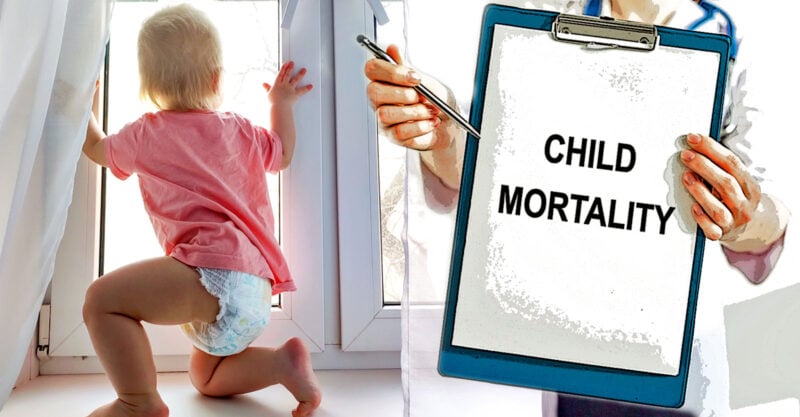Young Children Died at Higher Rates in 2021-2022, as Adult Life Expectancy Rebounded
Death rates among children ages 1-4 jumped 12% between 2021 and 2022, and for kids 5-14 the rate increased by 7% over the same period, according to data released this month by the CDC.
Miss a day, miss a lot. Subscribe to The Defender's Top News of the Day. It's free.
Death rates among children ages 1-4 jumped 12% between 2021 and 2022, and for kids 5-14 the rate increased by 7% over the same period, according to data released this month by the Centers for Disease Control and Prevention (CDC).
The rise in mortality for these young age groups reverses decades of progress in reducing childhood deaths, according to CNN.
The new data brief from the CDC’s National Center for Health Statistics also included information, first released in December 2023, about infant mortality rates, which rose 3.1% from 2021 to 2022 — the first increase in two decades.
Life expectancy for adults in the U.S. rebounded slightly in 2022, with the overall life expectancy rising to 77.5 years, according to the CDC.
However, the rise “offsets less than half of the 2.4 years of life lost in the first two years of the Covid-19 pandemic, and life expectancy is still lower than it’s been in about 20 years,” CNN reported.
Dr. Steven Woolf, director emeritus of the Virginia Commonwealth University Center on Society and Health, told CNN:
“Put simply, the fact that life expectancy in 2022 was lower than in 2019 means that Americans continue to die at higher rates than they did before the pandemic, despite the rebound.”
‘Every pediatrician, public health agency, and parent should be alarmed’
The increases in child mortality rates stand in stark contrast to the declines in mortality rates identified in all other age groups 15 and older. For example, the death rate for ages 15-24 decreased by 10.6%, and for ages 25-34, by 9.6%.

According to experts interviewed by CNN and The Defender, the increase in child mortality rates is especially concerning.
“This is a red flashing light about the poor health status of Americans and how it now puts our children at risk,” Woolf told CNN.
“This trend does not explain decreases in life expectancy for the total population, which is driven by deaths in adults,” Woolf said, “but it is alarming nonetheless because it means that our children, our most cherished population, are less likely to survive to adulthood.”
Brian Hooker, Ph.D., chief scientific officer at Children’s Health Defense, said he found it “stunning” that the younger age groups showed mortality rate increases while all other age groups experienced declines.
Dr. Michelle Perro, a pediatrician and author of “What’s Making Our Children Sick?,” called the statistics “a disaster” adding, “Every pediatrician, public health agency, and parent should be alarmed.”
For the December 2023 data on infant mortality rates, the CDC listed maternal complications, bacterial sepsis and respiratory distress of newborns, diseases of the circulatory system and sudden infant death syndrome, or SIDS, as possible causes.
However, in its data brief the agency did not offer possible explanations for the jump in mortality rates for the 1-4 and 5-14 age groups.
In a March 2023 editorial on youth mortality, Woolf pointed to homicides, suicides, drug overdoses and car accidents as the principal causes.
Perro acknowledged that poor diets, lack of exercise and over-exposure to electromagnetic radiation (EMR) contribute to chronic disease increases in pediatric populations.
However, both she and Hooker said they couldn’t rule out the introduction of COVID-19 vaccines for the younger age groups as possible contributing factors.
Perro told The Defender, “What has changed without a doubt is the introduction of the COVID vaccine — directly and indirectly through pregnant moms — for children 6 months and older.”
Perro said we are witnessing “the greatest pediacidal event of our lifetime,” adding that it is being covered up by the recent attempts “to normalize previously rare or unheard-of diseases such as heart attacks and strokes in childhood.”
According to Hooker, “It would be very difficult to rule out the introduction of the COVID-19 vaccine in this increase given that the vaccine wasn’t approved for ages down to 5 years until Oct. 29, 2021, and down to 6 months until June 17, 2022,” Hooker said, noting that childhood mortality from the virus had been “very low.”
Hooker added, “It is unfortunate that the woefully under-tested COVID-19 vaccine was given to pregnant women (without any testing) starting in 2021, and despite the narrative of the government-pharma cartel, we have to look at this as a potential causal factor.”
‘A lot of catching up’ on vaccines in 2022
Given the ever-increasing childhood vaccination schedule, COVID-19 vaccines may not be the sole driver of the observed trend in childhood mortality, according to James Lyons-Weiler, Ph.D., and Dr. Paul Thomas.
A 2020 study by Lyons-Weiler and Thomas found that vaccinated children had significantly more doctor visits for eye disorders, respiratory infections, asthma, allergies, ear infections and gastrointestinal disorders than unvaccinated children.
The study, published in the International Journal of Environmental Research and Public Health, was later retracted by the journal.
Thomas, a retired pediatrician and author of “The Vaccine-Friendly Plan: Dr. Paul’s Safe and Effective Approach to Immunity and Health- from Pregnancy Through Your Child’s Teen Years,” told The Defender the increase in deaths among infants and young children could be because in 2020 and 2021 pediatricians administered fewer vaccines when COVID-19 quarantines restricted “well child” visits, and therefore in 2022, “there was a lot of catching up with vaccines.”
Thomas said he also believes this could be behind the increase in sudden infant death syndrome, “which we know is much more common after vaccines than at any other time in an infant’s life,” he said.
The CDC data “are also hiding vaccine deaths as ‘suffocation’ so the SIDS numbers don’t look obviously too high, which would need to be explained,” he added.
Disturbing 5-year youth mortality trends
Reports over the last five years show a disturbing trend for the younger age groups. For ages 1-4, the 2018 rate of 24.0 deaths per 100,000 dipped to 23.3 in 2019 and 22.7 in 2020, only to increase to 25.0 in 2021 and 28.0 per 100,000 in 2022. The 2020-2022 data show a 23.4% jump.
For ages 5-14, the death rate steadily but slowly increased between 2018 and 2020, then jumped from 13.7 per 100,000 in 2020 to 14.3 in 2021 and 15.3 in 2022. The increase over five years is 15%, while the increase from 2020-2022 is 11.7%, which represents 78% of the total five-year increase.
According to USA Facts, between 2019 and 2021, the growing childhood death rates for all children ages 1-19 were due primarily to unintentional injuries, such as car accidents, drownings and fires, and homicides, suicides and drug overdoses.
Drug overdoses among children and teens nearly doubled between 2019 and 2021, with opioids like fentanyl a major contributor. This could be a result of pandemic measures like school closures, which contributed to the increase in mental health problems, including anxiety and depression, according to some experts, including those who referred to the situation as a mental health pandemic.
National Center for Health Statistics data from 2021 specifically for the 1-4 and 5-14-year-old age groups showed the following causes:

Sign up for free news and updates from Children’s Health Defense. CHD focuses on legal strategies to defend the health of our children and obtain justice for those injured. We can't do it without your support.





No comments:
Post a Comment